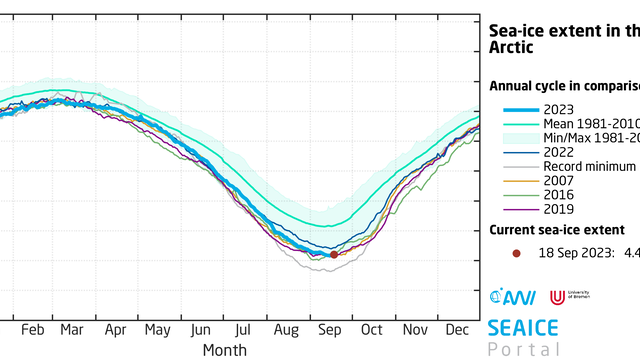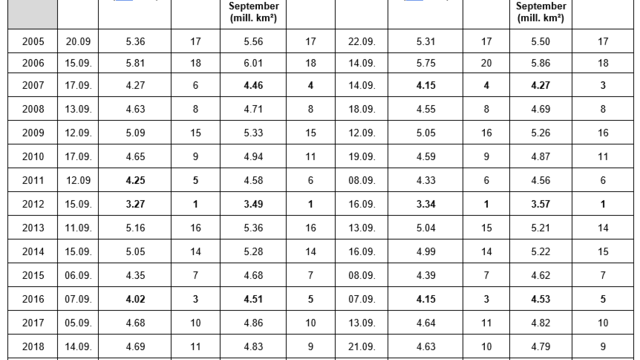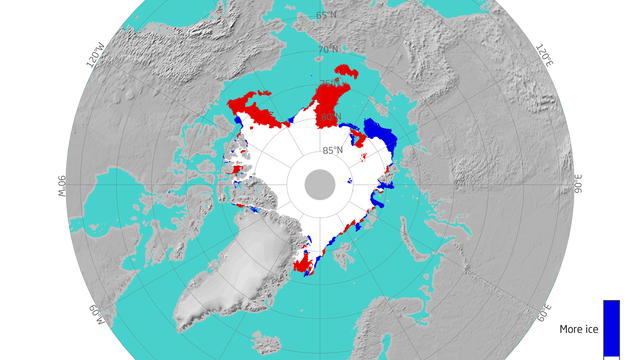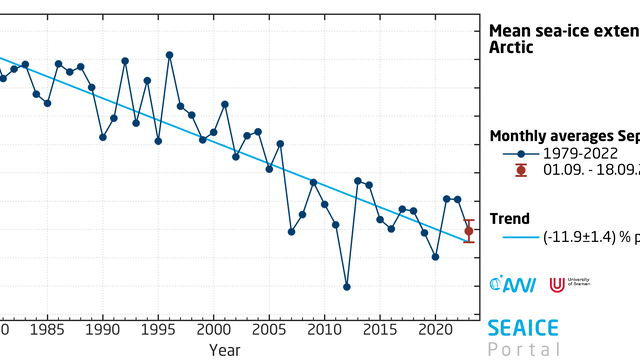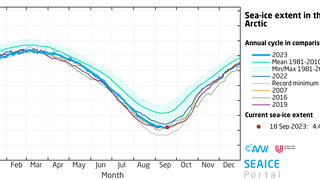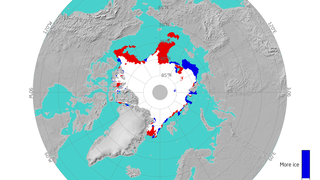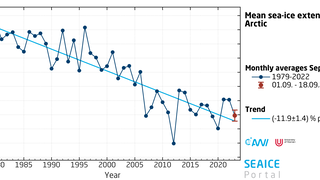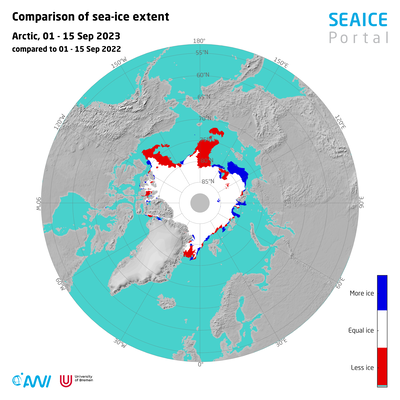This year, the minimum Arctic sea-ice extent, at 4.33 million km², was most probably reached on 15 September (Figure 1), putting it at 7th place in the sequence of minima since 1979. The sea ice had been at the lower edge of the minima/maxima range for the period 1981 – 2010 all year long and dropped significantly again in September. The monthly mean up to 18 September at 4.47 million km² was similar to the levels seen in 2016 (4.51 million km²) and 2007 (4.46 million km²), which are 5th and 4th place in the list of monthly mean values since 1979.
Table 1 shows the ice extents and monthly means since 2005 and their respective rankings. Figure 3 shows the monthly means for the years 1979 – 2022 and the position for this year up to 18 September. When the Arctic sea ice reached its annual minimum in September, broad sections of the Northeast and Northwest Passages were ice-free; only the central Arctic Ocean and the regions north of Greenland and parts of Canada had solid ice cover. Remarkably, ice retreat in the eastern Arctic progressed comparatively slowly this year. This was due to the influence of low-pressure systems, which were dominant in the Russian part of the Arctic throughout the summer. “These produced a somewhat unusual ice drift, with ice masses from the Central Arctic drifting into the Laptev Sea,” says Prof Christian Haas, Head of the AWI’s Sea Ice Section. Thanks to the steady flow of new ice from the north, parts of the Russian marginal seas still have relatively high ice cover. As Dr Thomas Krumpen, a sea-ice physicist at the AWI, adds: “This can also be seen in the ice thickness. Readings taken in the Arctic with the EM-Bird and a research aeroplane, and from on board our research icebreaker Polarstern, confirm higher ice thicknesses than generally seen in the past 15 years in the surveyed areas north of Greenland and in the eastern Arctic – a further indicator that the melting rates were lower this summer. In addition, laser readings taken in the eastern Arctic reveal that the ice is less deformed than usual. This could be due e.g. to less pronounced deformation processes during ice formation.” In September, particularly in the eastern Arctic between 150° East and 90 ° East, a zone with sea-ice concentrations of less than 50% formed, which contributed to the substantial ice retreat (see Figure 2).
First results from the Polarstern’s ongoing Arctic expedition
This summer, experts on board the research icebreaker Polarstern were underway in the eastern Arctic on expedition PS138 Arctwatch-1. Their goal: to once again assess the status quo and to conduct comparative analyses in the Arctic Ocean, helping gauge its development over the course of a decade. They returned to the same regions assessed in 2012 and used interdisciplinary process studies to investigate interactions between the ice physics, hydrography, biogeochemistry and biodiversity of the Arctic system, from the sea ice to the seafloor. Their on-site observations help to put the conditions in the Arctic this summer in perspective:
Snow and surface melting:
Readings taken on-site show that this year, uncharacteristically few melt ponds have formed on the ice; at the same time, there seems to have been a great deal of snow. Normally, there is very little snow on the ice at this time of year – which, beyond a few scattered patches, is normally found in snowdrifts behind pressure ridges – while melt ponds cover up to 50% of the surface. “We suspect that there was surface melting early in the summer, in June and July, but that it soon ended, which would explain the current situation. Afterwards, the surface refroze and was covered in snow. I find that highly unusual; it really sets this year apart,” says Dr Marcel Nicolaus, a sea-ice physicist at the AWI and currently on board RV Polarstern. However, in order to more precisely interpret these observations, the meteorological conditions over the past few months have to be analysed in detail.
Ice structure and underside melting:
In addition, the researchers found far more multiyear ice than expected. This is due to the fact that the sea ice (somewhat atypically) largely came from farther to the northwest and less from the Russian shelf seas. As a result, much of the ice had already survived a summer melting. Accordingly, the top two-thirds of the ice cores gathered during the expedition show considerable melting; after that, the ice refroze, then began melting again. This has a significant effect on the structure of the sea ice. In the bottom third of the cores, we can see the ice that formed last winter and is left behind after underside melting. The extent of this underside melting varied considerably among the eight sites sampled to date. “Nevertheless, generally speaking, we can say that the majority of the loss of mass, that is, the loss of thickness, took place on the underside of the ice, not the surface. In our ice cores, the underside showed extensive melting, which we can also clearly see in all the videos we took with our ROV (Remote Operated Vehicle): The underside of the ice has melted very ‘smoothly’,” Marcel Nicolaus explains.
Freshwater:
Moreover, this year less meltwater (=freshwater) was found than in past years. This is likely due to the fact that surface melting was less pronounced than usual. There are most likely a number of causes, all of which are interconnected. One aspect is the reduced surface melting just mentioned, but further factors could include the drift and the provenance of the ice – and with it, the provenance of the near-surface water masses, which transported less freshwater than usual from the Siberian shelves.
In summary, the current situation in the Arctic differs considerably from past summers, though it doesn’t represent a break with the general trend of progressive ice loss in summer. This calls for a detailed analysis of the findings in the context of this year’s extreme weather conditions in the Northern Hemisphere, which would allow us to better judge and predict the causal relations and future developments.
Contact
Questions?
Write us an
email or use the contact form.
Graphics
